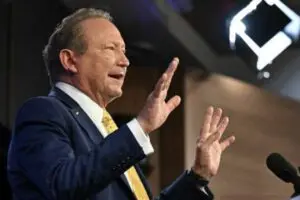The Morrison government’s modelling of a net zero emissions target is being “verified” by Brian Fisher, a consultant who authored modelling used by the Coalition to attack the climate policies put forward by Labor in the 2019 federal election campaign.
Officials from the Department of Industry, Science, Energy and Resources confirmed that consultancy BAEconomics, headed by Fisher, was paid more than $100,000 at various points this year to “validate” modelling prepared for a zero net emissions target.
Deputy secretary Jo Evans was asked in a Senate estimates hearing by Australian Greens senator Sarah Hanson-Young to provide details of two contracts awarded to BAEconomics during 2021 for modelling and “analytical benchmarking and verification”.
“Fisher has one of the few comparable versions of the general equilibrium model that we are using in the department. And we used him to validate some of the results that we were using, and that we were coming up with,” Evans told Senate Estimates.
“We had two separate contracts with him; one for $72,600, which was early on to give us confidence in what we were setting out to do with our own version of [Computable general equilibrium models].
“And the second [worth $33,000] to do some additional modelling on a particular aspect of what we were trying to do. We just needed to test whether what we had proposed would work,” Evans added.
Department officials tell senate #Estimates that they engaged Brian Fisher to validate the government's modelling of a net zero target.
Fisher produced modelling that was used to attack the Labor party's policies ahead of the 2019 federal election. pic.twitter.com/tSSG49WKtO— Michael Mazengarb (@MichaelM_ACT) October 25, 2021
Evans was asked whether anyone within the department had raised concerns regarding Fisher’s engagement, given Fisher had previously produced modelling used as part of a political attack on Labor’s climate policies, but Evans defended Fisher’s expertise.
“I would say the department has a high regard for Mr Fisher’s technical expertise in running [computable general equilibrium] models,” Evans said.
In response to the revelation, federal energy and climate spokesperson, Chris Bowen, tweeted that “you couldn’t make this stuff up.”
“This goes from bad to worse. After having run years of dishonesty about the economic implications of climate change, these guys hide their own modelling and then reveal, under questioning, that the modelling was done by Mr Fisher,” Bowen told RenewEconomy.
The Morrison government has refused to release the details of modelling it has completed of a zero net emissions target, with Taylor making a ‘public interest immunity’ claim to refuse to comply with an order of the senate to table the modelling in parliament.
The Morrison government looks set to adopt a formal target of zero net emissions by 2050, but the policies underpinning this target and the concessions granted to the Nationals in return for their support have remained secret.
Australian Greens leader Adam Bandt said that the involvement of Fisher in the development of the Morrison government’s climate policies undermined its integrity.
“Burning more gas in a net zero world, as this modelling ‘predicts’ shows the 2050 deal is a fraud,” Bandt said.
“Just when we thought this government couldn’t get any more disgraceful, they stoop lower. Employing a known friend of the fossil fuel industry to model net zero while expanding gas exports proves this government has no interesting in curbing the climate crisis.”
The Morrison government has consistently attacked the federal Labor opposition for adopting more ambitious emissions reduction targets without producing economic modelling of the costs. These attacks have also been levied on opposition parties by some sections of the media.
The modelling by Fisher became prominent in the election campaign, and his work was widely criticised for over-inflating the costs of Labor’s climate targets, including by significantly overestimating the cost for renewable energy technologies.
Fisher’s modelling claimed that Labor’s policies could cost the economy as much as $542 billion in lost gross domestic product and cause more than 150,000 in job losses. They were scary numbers that helped deter some voters from backing a switch to a Bill Shorten-led government.
The Climate Council labelled the modelling as “deeply flawed”. It noted that the modelling did not account for any of the economic benefits of taking more ambitious action on climate change.
The Australian Renewable Energy Agency also sought to debunk Fisher’s modelling. Ironically, a year later, the co-founder of Fisher’s BAEconomics, Anna Matysek, was appointed by Taylor to the ARENA board.
Despite Fisher’s scare mongering, analysis now suggests that – thanks to state and territory government policy – Australia could be on track to reduce emissions by a level comparable to the targets taken by Labor to the 2019 election – a 2030 target for a 45 per cent reduction – without any prospect of economic impacts of the scale predicted by Fisher.
Fisher was also engaged as part of an Abbott government-commissioned review of the federal Renewable Energy Target, led by Dick Warburton, which recommended that the target be slashed. Taylor was a vigorous opponent of the RET.
Following the 2019 election, Fisher was appointed by Taylor to the federal government’s Emissions Reduction Assurance Committee, a body that has oversight of government-approved methodologies for carbon offset projects, which have also been criticised by independent analysts.
The Department of Industry, Science, Energy and Resources has been contacted for further comment.










